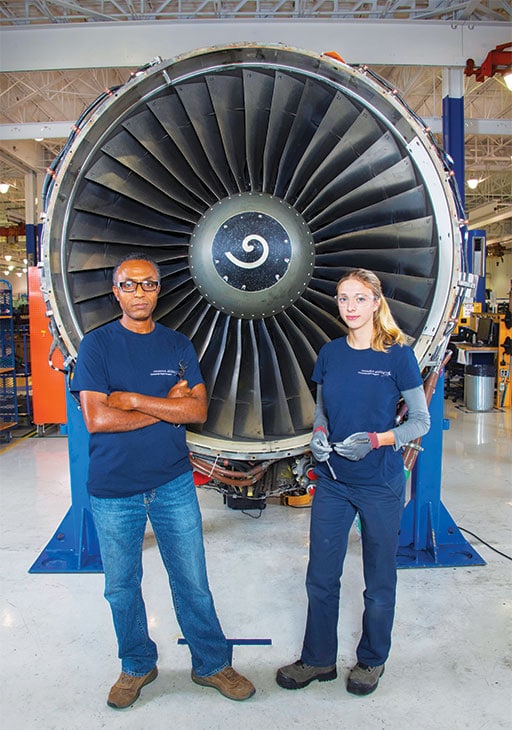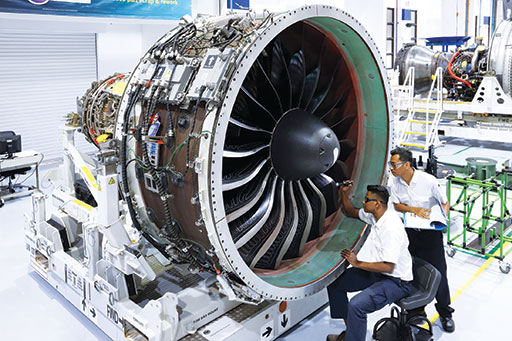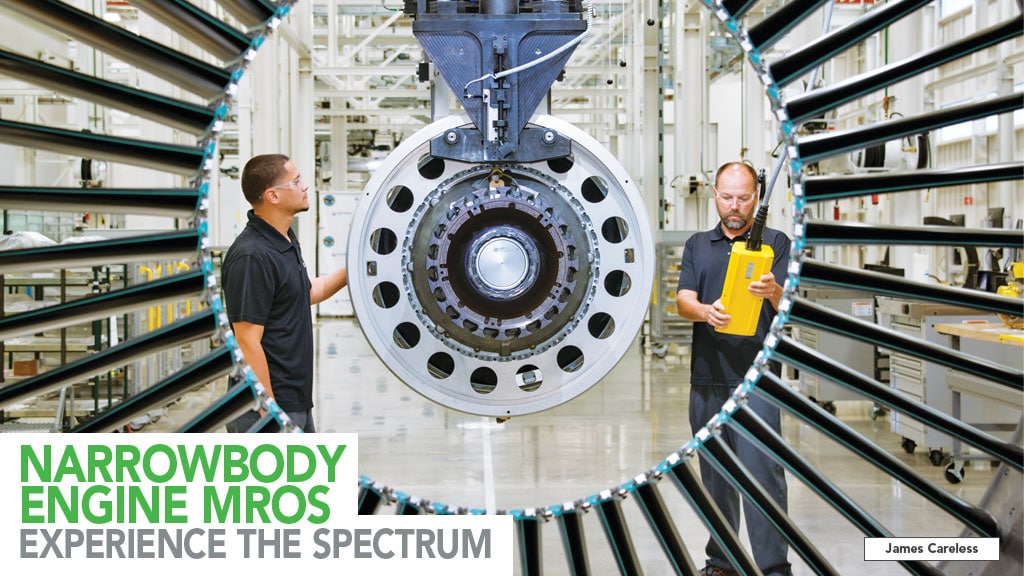Back in June 2021, Aviation Maintenance magazine heard from widebody engine MROs with respect to the challenges they’re currently facing in serving airline clients, the support programs they provide to help these clients manage their engine maintenance costs, and the advice these MROs had to offer clients for getting more value from their services (‘Widebody Engine MROs Talk About Challenges, Support Programs and Advice to Customers’).
It is now time for narrowbody engine MROs to share their views on the same topics. Here’s what they had to tell us.
AFI-KLM E&M
In addition to accommodating widebody engine clients, AFI-KLM E&M’s MRO facilities in Amsterdam-Schiphol, Paris-Charles de Gaulle and Paris-Orly offer narrowbody engine maintenance and overhaul services on the CFM International (GE Aviation-Safran) CFM56 engine used on Airbus A/318/A319/A320/A321 and Boeing 737 Next Generation airliners. AFI-KLM E&M provides the same level of support to the CFM International LEAP engine, which is being used on the Airbus A320neo, Boeing 737 MAX and Comac C919.
Their biggest challenge? Keeping these engines serviced during pandemic shutdowns and parts shipping delays has been difficult, but AFI-KLM E&M has been able to cope. “In the current COVID situation it is essential to manage the supply chain in order to lower maintenance costs, and to be creative and innovative to get through this period,” said Michael Grootenboer, AFI-KLM E&M senior vice president Engine of Group Engine Products. “Industry-wide, it will be a further challenge to manage the supply chain and the pressure on overhaul capacity once traffic starts picking up again.”

To help its airline narrowbody engine clients keep their costs under control — especially now when cash is tight due to COVID — AFI-KLM E&M offers a range of service contracts based on different pricing models. These pricing models include Cost per Flight Hours, Firm Fixed Price (FFP), Not to Exceed (NTE), and Time & Materials (T&M). “The model provided depends on each customer’s operations,” Grootenboer said. “We adapt our answer to be the best fit for each customer.”
When it comes to offering value-maximizing advice to narrowbody engine customers, Michael Grootenboer’s answer is short and sweet: Book your shop visits now to ensure that you can be served in a timely manner. “Airlines have avoided engine overhauls to preserve cash because of the Coronavirus crisis,” he explained. “MRO capacity will be scarce when the market picks up again and increased traffic will be back to 2019 levels for narrowbodies first. So securing engine MRO slots now to keep your operations going is essential.”
Lockheed Martin Commercial Engine Solutions
Lockheed Martin Commercial Engine Solutions (LMCES) provides full overhaul capability for Airbus and Boeing narrowbody engine platforms such as the CFM56-5A/-5B (A320 engines), CFM56-7B (B737 engines), and CFM56-3 (older generation B737 engines). LMCES also maintains non-narrowbody engines including CF34-3 (regional jet engines), and CF6-50 (widebody military refueling tanker engines). All MRO work is performed at the LMCES engine shop in Montreal, Canada.
From LMCES’ vantage point, there is one primary business challenge dogging the airline and MRO industries — COVID-19.
“Globally, narrowbody operators continue to be adversely impacted by the pandemic,” said David Bridges, LMCES’ director of Strategy & Business Development. Their cash flow woes are trickling down to the MRO industry. “Although many U.S.-based operators have experienced a recovery in their passenger service, most remain engaged in aggressive efforts to avoid or delay expensive engine overhauls whenever possible,” he said. “Some of those efforts involve the renegotiation of aircraft lease return conditions and utilizing remaining life from ‘green-time’ engines to avoid short-term engine maintenance costs. In general, most of the airlines operating narrowbody aircraft are seeking flexible, customized work scope solutions for any engines that require in-shop maintenance,”

The numbers tell a stark tale: According to LMCES, commercial demand for engine MRO services across the industry was roughly cut in half in 2020 because of COVID. To stay afloat financially, this MRO shifted its short-term focus to narrowbody aircraft lessors and military opportunities.
The results of this focus shift have apparently paid off. In late 2020, LMCES signed a long-term narrowbody engine service agreement with leasing company Fortress Transportation and Infrastructure Investors LLC (FTAI) for CFM56-5B/-7B engines. LMCES also signed a long-term MRO contract with the United States Air Force for its F108 engine, which is the military version of the CFM56-2.
“LMCES continues to anticipate strong demand from its military sustainment customers through contracts with the U.S. government for KC-10 and F-108 engines going forward,” said Bridges. “With more than $1 billion in new contracts, our team is proud to be growing with many career opportunities to join the team in Montreal.”
Back to the airline MRO business: When it comes to narrowbody engine service plans, “commercial customers mostly desire, and LMCES mostly offers, Firm Fixed Price (FFP) contract options,” Bridges said. “FFPs allow LMCES to work closely with its customers to optimize costs.”
“Conversely, Time & Material (T&M) programs shift risk to customers while Flight Hour Agreements (FHAs) shift risk to the MRO,” he observed. “Neither T&Ms nor FHAs allow as many opportunities as possible for collaboration on engine cost reduction.”
When it comes to getting more value for their engine MRO dollars, David Bridges’ advice to narrowbody engine owners is to take advantage of a new joint venture between LMCES and FTAI called ‘The Module Factory’. It is a dedicated commercial engine maintenance center operated by LMCES that focuses on the modular repair and refurbishment of CFM56-7B and CFM56-5B engines. “The Module Factory offers a unique product from typical engine MRO work by utilizing plug-and-play modules and standardized work scopes,” he explained. “It is designed to significantly lower turn-around-times (TATs) and to lower cost per cycle for narrowbody engine customers.”
MTU
MTU Maintenance is predominantly focussed on the narrowbody engine MRO market. They offer full overhaul services for:
• CFM56-7B engines at MTU Maintenance Hannover and MTU Maintenance Berlin-Brandenburg, CFM56-5B/7B engines MTU Maintenance Zhuhai, and the CFM56-2 variant at MTU Maintenance Canada;
• International Aero Engines (IAE) V2500 engines (Airbus A320 family, McDonnell-Douglas MD-90, and Embraer KC-390) at MTU Maintenance Canada, MTU Maintenance Hannover and MTU Maintenance Zhuhai;
• Pratt & Whitney PW1100G-JM engines (Airbus A320neo) at MTU Maintenance Hannover and EME Aero, with services being added at MTU Maintenance Zhuhai (while some PW1100G-JM piece part repairs are also carried out at MTU Maintenance Berlin and MTU Aero Engines in Munich);
• LEAP-1B and soon LEAP-1A engines at MTU Maintenance Zhuhai;
• Pratt & Whitney PW2000 engines (various aircraft including Boeing 757s) at MTU’s Hannover facility.
As with other narrowbody engine MROs interviewed for this story, coping with COVID remains a major challenge for MTU — in this case, dealing with growing and unpredictable demand as airline travel returns to normal worldwide.

“Some positive signs have already been observed in Asia (where 85% of China’s fleet is now active), North America (over 70% active) and Europe as regional and domestic travel has started to recover,” said Fabian Schoen, MTU Maintenance’s director of Programs. “This renewed traffic has predominantly been with narrowbody engine aircraft. We are prepared for this and expect to see our MRO levels recover in 2022/23. Furthermore, we retained our highly-qualified staff during the pandemic and are ready to support our clients as the recovery occurs.”
As for service programs? Given the wide range of narrowbody engines supported by MTU, it makes sense that the company does so in a variety of ways.
“For operators of newer engines, our focus is on generating more flight hours with customized solutions,” said Schoen. “We achieve this by intelligent fleet management that optimizes removals across a defined period. Such services are complemented by predictive maintenance, based on engine trend monitoring, on-site services and spare engine support.”
When it is time for a newer engine to make an MTU shop visit, this MRO reduces the engine’s servicing costs through a combination of customized work scoping, advanced EASA-FAA approved repairs and engineering expertise to help lower overall costs. “We call this program PERFORMPlus,” Schoen said. “It is particularly relevant for customers preparing for increased flight schedules later in the year.”
MTU’s SAVEPlus program for mature narrowbody engines — which typically require more work in the shop — is meant to keep their costs down as well. To make this happen, “our solutions include smart repairs and tailored work scopes to suit operators’ remaining flight periods, as well as material salvation and intelligent teardowns,” Schoen said. These services can be combined with MRO alternatives such as leasing green-time engines to clients through MTU Maintenance Lease Services or exchanging less-mature engines in alignment with the aircraft’s remaining lifespan. “Furthermore, we offer all service contract types including Fly-by-Hour and Time & Material,” said Schoen.
When it comes to client advice, MTU doesn’t offer any one-size-fits-all wisdom for narrowbody engine owners/operators. But the company does recommend that clients talk to their MROs about their needs as soon as possible, to ensure that they can be met in a timely manner as global airline traffic ramps back up.
“Currently, fleet planning is highly dynamic, so we are working with our customers on finding the best solutions for their fleets, to enable our customers to get the most engine life and value from their assets,” Schoen told Aviation Maintenance magazine. “In doing this, we expect to see a continued trend away from traditional planning with fixed maintenance intervals to more individually-tailored solutions. Some airlines are concentrating on short-term savings with cash preservation as the main objective, while others are focusing on long-term planning. MRO providers must flexibly meet both these goals to provide the best solution for customers in today’s market.”
Pratt & Whitney
Pratt & Whitney has MRO service centers around the globe. There are nine International Aero Engines (IAE) party company facilities, Pratt & Whitney being a key partner in the IAE consortium. Three of those IAE MROs are managed directly by the famed engine manufacturer and its joint ventures. There are also nine active GTF MRO shops in Pratt & Whitney’s GTF MRO network.
Not surprisingly, Pratt & Whitney services a whole range of airliner engines. They include the PW1900G (Embraer E-Jets E190-E2/E195-E2), PW1500G (Airbus A220), PW1100G-JM, V2500 A320ceo family, PW2000, and the CFM56.
Beyond the inherent technical intricacies involved with maintaining and overhauling jet engines, COVID-19 has been the biggest business challenge facing the company in recent months. “We saw several trends during the pandemic,” said Joe Sylvestro, Pratt & Whitney’s vice president of Aftermarket Global Operations. “Among these: Aircraft powered by Pratt & Whitney GTF engines were often the last to stop flying and the first to return to service due to the engine’s fuel efficiency. Cargo aircraft were less impacted by the pandemic than passenger aircraft: In fact, last October the first A321 passenger to freighter conversion aircraft powered by V2500 engines was delivered to Qantas Freight. And, in general, narrowbody aircraft operators were able to benefit from green-time engine management.”
According to Sylvestro, Pratt & Whitney’s close relationships with customers gave his company “good visibility” around forecasting and scheduling maintenance, which allowed Pratt & Whitney to tailor its maintenance strategies to address the realities of the pandemic. “For example, with many aircraft inactive during the pandemic, we had a window of opportunity to incorporate planned upgrades into the GTF fleet,” he said. “Rather than slow down MRO activity, we accelerated upgrades and restored the fleet to full readiness in anticipation of the recovery. We’re currently at a world-class 99.97% dispatch reliability rate on the Airbus 320neo fleet.”
Pratt & Whitney addresses its clients’ need for service programs/contracts through its suite of EngineWise solutions. Sylvestro said his MRO offers a wide variety of customizable work scopes and payment options for both cargo and passenger air carriers. “Our comprehensive maintenance plans provide a turnkey solution where we will cover most aspects involved in engine maintenance, from health monitoring, to tailored overhaul planning, to execution of the overhauls on a dollar per flight hour basis,” he explained. “On the other end of the spectrum, we also offer transactional plans that allow the customer to bring in their engines when they choose and provide them full control over the work scope. We work closely with our customers to provide the solution that works best for them.”

Joe Sylvestro’s advice to narrowbody engine owners/operators is to keep in touch with Pratt & Whitney on an ongoing basis, so that their MRO needs can be managed efficiently and effectively. “Staying in communication is key,” he said. “If an operator can help us understand their needs, we can in turn respond more holistically to reach the best outcome.”
StandardAero
StandardAero provides MRO services for the CFM International CFM56-7B at the company’s Plant 6 facility in Winnipeg, Canada, which includes two test cells. The company is a GE Designated Fulfillment Center for the CFM56-7B and an independent TRUEngine authorized MRO provider for this engine type as well.
“We launched our CFM56-7B program in June 2009, after being selected to support WestJet’s fleet of engines under an exclusive 13-year OnPoint solution contracted by the airline with GE Aviation,” said David Green, StandardAero’s vice president/general manager CFM56/CF34. “GE subsequently agreed to extend the offload program to include engines from other airlines supported under long-term agreements with the OEM.” StandardAero also supports the CFM56-7B engines powering the U.S. Navy’s P-8A Poseidon maritime patrol aircraft fleet including engine health monitoring (EHM) support for both the CFM56-7B and the -5B variant.
When it comes to the narrowbody engine MRO business, “our biggest challenge right now is actually staffing back up to meeting resurgent demand from airlines,” Green said. “We are fortunate that the North American market, the most important for us in terms of our customer base, has rebounded strongly after the downturn of 2020, and this is driving a significant uptick in shop visits. This is allowing us to rehire many of those employees we were forced to lay off a year ago, though we now find ourselves competing with other aerospace companies for skilled technicians, as the whole industry enters a hiring phase.”
Onto StandardAero’s narrowbody engine service programs. As a GE Designated Fulfillment Center and TRUEngine authorized MRO provider for the CFM56-7B, this MRO offers a full range of OEM-authorized services for this engine. Meanwhile, to address the varying needs of its clients. StandardAero offers service contract options such as flat-rate agreements (FRA), FFP, NTE, Power-by-Hour (PBH), Power-by-Cycle (PBC), and T&M.
“Our contracts can include a range of services, including scheduled MRO, unscheduled engine removals (UERs), engineering, EHM and field service support,” said Bridges. “In terms of financing, while StandardAero does not offer in-house financing we do have agreements and relationships with various financiers, including Export Development Canada (EDC).”
Like the other MROs in this article, David Bridges advise narrowbody engine owner/operators not to delay on booking shop visits any longer. “Demand for shop visits is already rebounding strongly, driven in part by events that were deferred for cost reasons during the worst of the COVID-19 related travel slump,” he said. “As a result, operators may be surprised to find that shops are not able to offer immediate induction dates.”
